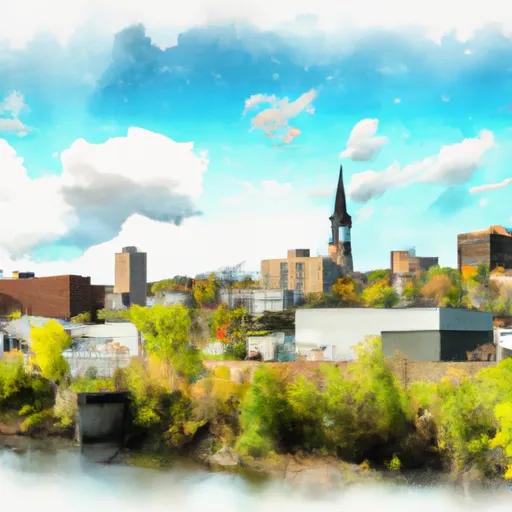-
 Snoflo Premium
Snoflo Premium
Get unlimited access to all our content
With no Ad interruptions! - Start Your Free Trial Login with existing account
Little-Falls
Eden Index
Climate
6.0
•
Recreation
4.1
•
Community
2.7
•
Safeguard
4.5/10

Little Falls, Minnesota is a charming city located in Morrison County. It experiences a continental climate with warm summers and cold winters. Average temperatures range from 12°F (-11°C) in January to 81°F (27°C) in July. Precipitation is relatively evenly distributed throughout the year with an average of 30 inches (76 cm) annually.
Nestled along the banks of the Mississippi River, Little Falls benefits from its hydrology constituents. The river offers picturesque views, recreational activities, and opportunities for boating, fishing, and kayaking. The pristine Ripley Creek also flows through the city, providing additional outdoor options.
With its natural surroundings, Little Falls offers a plethora of outdoor recreation opportunities. Charles A. Lindbergh State Park is a popular destination, providing hiking trails, picnic areas, and camping facilities. Visitors can explore the historic home of aviator Charles Lindbergh and learn about his accomplishments. Pine Grove Park offers scenic walking paths, a disc golf course, and access to the Mississippi River. Golf enthusiasts can enjoy the scenic Little Falls Country Club.
Overall, Little Falls, Minnesota offers a favorable climate, abundant hydrology constituents, and a range of outdoor recreation opportunities, making it an attractive destination for nature lovers and outdoor enthusiasts.
What is the Eden Index?
The Snoflo Eden Index serves as a comprehensive rating system for regions, evaluating their desirability through a holistic assessment of climate health, outdoor recreation opportunities, and natural disaster risk, acknowledging the profound impact of these factors on livability and well-being.
Climate Health Indicator (CHI): 6.0
Little-Falls receives approximately
680mm of rain per year,
with humidity levels near 83%
and air temperatures averaging around
7°C.
Little-Falls has a plant hardyness factor of
4, meaning
plants and agriculture in this region thrive during a short period during spring and early summer. Most
plants will die off during the colder winter months.
By considering the ideal temperature range, reliable water supplies, clean air, and stable seasonal rain or snowpacks, the Climate Health Indicator (CHI) underscores the significance of a healthy climate as the foundation for quality living.
A healthy climate is paramount for ensuring a high quality of life and livability in a region, fostering both physical well-being and environmental harmony. This can be characterized by ideal temperatures, reliable access to water supplies, clean air, and consistent seasonal rain or snowpacks.
Weather Forecast
Streamflow Conditions
Mississippi Headwaters
Area Rivers
Mississippi Headwaters
Snowpack Depths
Mississippi Headwaters
Reservoir Storage Capacity
Mississippi Headwaters
Groundwater Levels
Recreational Opportunity Index (ROI): 4.1
The Recreational Opportunity Index (ROI) recognizes the value of outdoor recreational options, such as parks, hiking trails, camping sites, and fishing spots, while acknowledging that climate plays a pivotal role in ensuring the comfort and consistency of these experiences.
Access to outdoor recreational opportunities, encompassing activities such as parks, hiking, camping, and fishing, is crucial for overall well-being, and the climate plays a pivotal role in enabling and enhancing these experiences, ensuring that individuals can engage in nature-based activities comfortably and consistently.
Camping Areas
| Campground | Campsites | Reservations | Toilets | Showers | Elevation |
|---|---|---|---|---|---|
| Camp Cassaway | 10 | 1,306 ft | |||
| Leech Lake Rec Area | 78 | 1,313 ft | |||
| Washkish Park | 30 | 1,180 ft | |||
| Winnie | 35 | 1,392 ft | |||
| Chippewa Loop | 46 | 1,369 ft | |||
| Knutson Dam | 14 | 1,307 ft | |||
| Cass Lake | 23 | 1,335 ft | |||
| Stony Point | 44 | 1,336 ft | |||
| Lum City Park | 18 | 1,194 ft | |||
| Big Bog State Rec Area | 31 | 1,177 ft |
Nearby Ski Areas
Catastrophe Safeguard Index (CSI):
The Catastrophe Safeguard Index (CSI) recognizes that natural disaster risk, encompassing floods, fires, hurricanes, and tornadoes, can drastically affect safety and the overall appeal of an area.
The level of natural disaster risk in a region significantly affects safety and the overall livability, with climate change amplifying these risks by potentially increasing the frequency and intensity of events like floods, fires, hurricanes, and tornadoes, thereby posing substantial challenges to community resilience and well-being.
Community Resilience Indicator (CRI): 2.7
The Community Resilience Indicator (CRI) recognizes that education, healthcare, and socioeconomics are crucial to the well-being of a region. The CRI acknowledges the profound impact of these elements on residents' overall quality of life. By evaluating educational resources, healthcare accessibility, and economic inclusivity, the index captures the essential aspects that contribute to a thriving community, fostering resident satisfaction, equity, and social cohesion.

